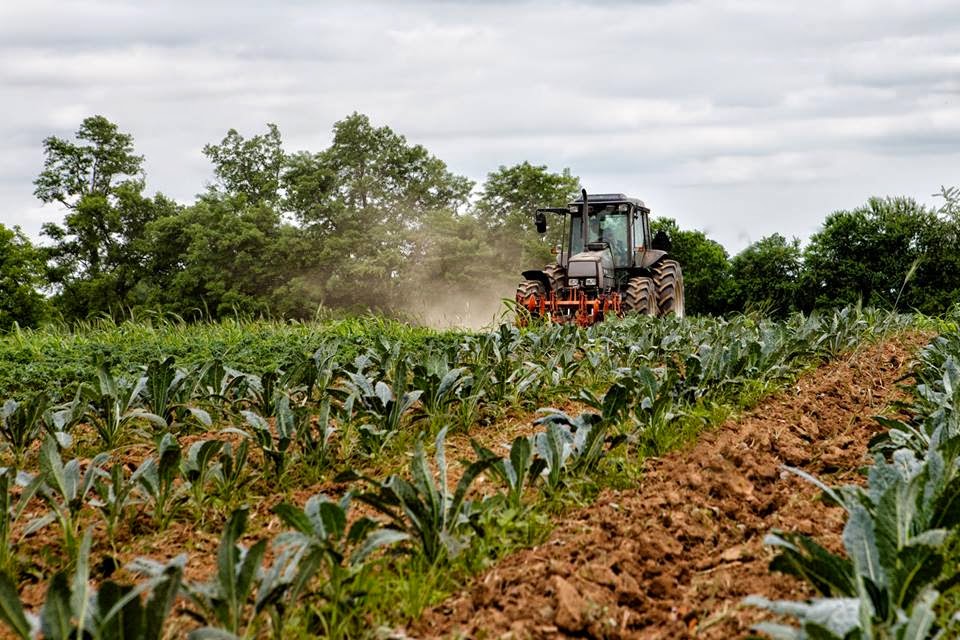Many shoppers at a farmers market have
ideas in their head about food, which guides their decision making, often
leaving them frustrated and empty handed. Some of this is from BIG food
marketing campaigns with the help of the USDA and FDA, or from repeated
messages from supermarket chains. Others have ideas that go back to their
childhood days, visiting their grandparent’s farm. Some of these people are
missing out on some really good food because of these misconceptions.
Let’s start with “new potatoes”. For some
reason, many people think this means small, round red potatoes, and they are
the only kind that should be cooked with green beans. In fact, new potatoes are
any and all varieties when freshly dug. These spuds are almost as exciting as
the first tomato of the season. Potatoes size up depending on variety and
growing conditions, and then the skin develops around them as a protection
mechanism. We usually get excited to sample the crop and dig some before the
skin is fully set, meaning a little thinner. These are hard to handle as the
skin has a tendency to smudge, making them unsightly, but they are really,
really good. The tubers have higher moisture content, and may even take longer
to cook. At the farm, we will begin to harvest the entire crop in the coming
week when the soil moisture conditions are right, and if the weather
permits. Soon you will have many shapes
and sizes of “new” potatoes to enjoy. With a good skin set and proper storage
conditions, the natural quality control mechanism will allow us to provide them
to you throughout the fall and winter.
This time of year people ask, “Is this
‘silver queen corn’?” When we tell them we have a nice white or bi-color super
sweet variety, we get an indignant look of disgust and they storm off in search
of something else. Silver queen was one of the early corns bred for sweetness
and white color, to distinguish itself from its yellow predecessors. Back in
the day, people ate ‘roasting ears’ which were simply immature ears of field corn,
grown for grain for livestock. The window when these were good was quite short;
being the sugars had not turned to starch yet. Silver queen was also bred to
slow this transition of sugar to starch and grow a big ear on a big sturdy
stalk. However, when an ear of corn is pulled from the plant, the sugars begin
the transition to starch as a self-protection mechanism in an effort to develop
a viable seed. The thousands of “super sweet” varieties are bred to slow this
transition of sugar to starch after harvest along with many other production
and eating quality attributes. Quick cooling also slows this natural
progression. If you can get the water hot before you pick the corn, then by all
means enjoy some silver queen corn. Otherwise, enjoy the many varieties of organic
sweet corn we grow for you, knowing it does not have to be silver queen to be
good. You should also be aware that there are many varieties of GMO sweet corn at
the farmers market (especially this time of the year), but our certified
organic production will never subject you to these.
Several people come up to our meat table
and say they only like fresh chicken and refuse to consider our frozen product when
at the market. We are glad to offer fresh chicken a few days during the summer directly
after processing, as it simply eliminates the thawing process or it helps with convenience
because one can take fresh chicken home and eat it the same day. However, it is
not feasible for us to harvest on a weekly basis, and it is easier for a
consumer to maintain food safety with frozen meat over fresh, so offering
frozen product is the best for everybody. The ‘fresh’ chicken in the grocery
store is a bit of a misnomer, as ‘thawed’ might be a more accurate term. BIG
chicken is allowed to hold product at 26 degrees, then sell it as fresh. A
whole chicken at 26 degrees would feel hard, like a bowling ball. The USDA
changed this designation to help balance the supply and demand of perishable
products. So, due to a little confusion, misconceptions or incorrect
assumptions, many shoppers are passing up an opportunity to enjoy a GMO grain-free,
pastured, organic frozen product, to eat a thawed, who-knows-how-it-was-raised bird.
In Your Share :
Snap Beans
Kale Greens
Fresh Herb
Lettuce
Bell Pepper
Potatoes
Summer Squash
Tomatoes
Okra
Garlic
Green Onion
Recipes:
Summer Squash Rice Casserole, makes 12 servings
1 1/2 C long-grain brown rice
3 C chicken broth
4 C diced summer squash (about 1
pound)
2 red or green bell peppers,
chopped
1 large onion, diced
3/4 tsp salt
1 1/2 C low-fat milk
3 T all-purpose flour
2 C shredded pepper Jack cheese,
divided
1 C fresh or frozen (thawed) corn
kernels
2 tsp extra-virgin olive oil
8 oz turkey sausage, casings
removed
4 oz cream cheese (Neufchâtel)
1/4 C chopped pickled jalapeños
Preheat oven to 375°F. Pour rice into a 9-by-13-inch baking dish.
Bring broth to a simmer in a small saucepan. Stir hot broth into the rice along
with squash, bell peppers, onion and salt. Cover with foil. Bake for 45
minutes. Remove foil and continue baking until the rice is tender and most of
the liquid is absorbed, 35 to 45 minutes more.
Meanwhile, whisk milk and flour in
a small saucepan. Cook over medium heat until bubbling and thickened, 3 to 4
minutes. Reduce heat to low. Add 1 1/2 C Jack cheese and corn and cook,
stirring, until the cheese is melted. Set aside.
Heat oil in a large skillet over
medium heat and add sausage. Cook, stirring and breaking the sausage into small
pieces with a spoon, until lightly browned and no longer pink, about 4 minutes.
When the rice is done, stir in the
sausage and cheese sauce. Sprinkle the remaining 1/2 C Jack cheese on top and
dollop cream cheese by the teaspoonful over the casserole. Top with jalapeños. Return
the casserole to the oven and bake until the cheese is melted, about 10
minutes. Let stand for about 10 minutes before serving.
Tomato Pie
5
tomatoes, peeled and sliced (Roma work best)
10
fresh basil leaves, chopped
1/2
cup chopped green onion or sweet onion
1
(9-inch) prebaked deep dish pie shell
1
cup grated mozzarella
1
cup grated cheddar
3/4
cup mayonnaise (or half mayo, half Greek yogurt)
2
T fresh grated Parmesan Cheese
Salt
and pepper
Preheat
oven to 350 degrees F. Place the
tomatoes in a colander in the sink in 1 layer. Sprinkle with salt and allow to
drain for 10 minutes. Use a paper towel to pat fry the tomatoes and make sure
all of the juice is out. (You don't want wet tomatoes or your pie will turn out
soggy). Layer the tomato slices, basil,
and onion in pie shell. Season with salt and pepper. Combine the grated cheeses
and mayonnaise together. Spread mixture on top of the tomatoes and sprinkle
parmesan cheese on top. Bake for 30 minutes or until lightly browned. To serve, cut into slices and serve warm.
Grilled-Stuffed
Mini Bell Peppers
8
mini bell peppers, rinsed and cut in half lengthwise (remove any seeds)
1
tablespoon lime juice
1
tablespoon chopped cilantro
1
green onion, chopped
3
ounces reduced fat cream cheese, softened
3
tablespoons light sour cream
Salt,
pepper Cooking spray
Heat
grill or grill pan to medium-high heat. In a small bowl combine reduced fat
cream cheese, light sour cream, lime juice, cilantro, and green onion. Lightly
salt and pepper each pepper, then scoop a small amount of filling in each.
Spray the grill pan or grill rack with non-stick cooking spray, then place the
peppers on the grill and cook for about 7-8 minutes, or until the bottoms of
the peppers have a nice char to them.




